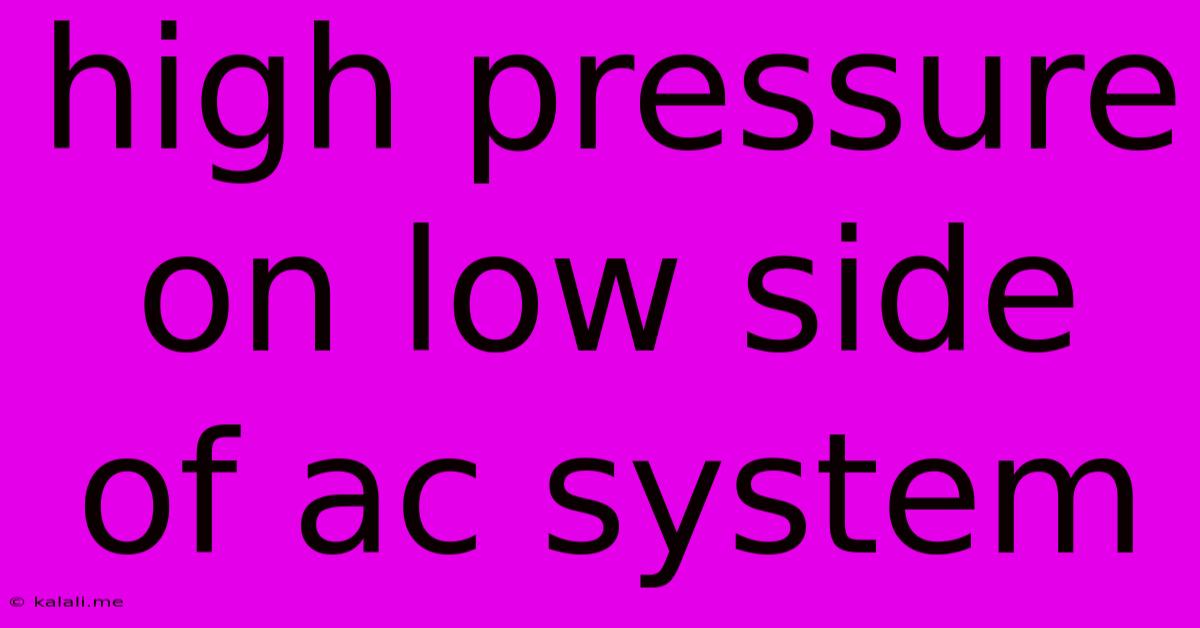High Pressure On Low Side Of Ac System
Kalali
Jun 05, 2025 · 4 min read

Table of Contents
High Pressure on the Low Side of an AC System: Diagnosis and Solutions
A critical aspect of maintaining a properly functioning air conditioning system is understanding its pressure readings. While high pressure on the high side is expected, finding high pressure on the low side indicates a serious problem that needs immediate attention. This article will delve into the causes of this issue, the diagnostic steps involved, and the potential solutions. Understanding this can prevent costly repairs and ensure your AC unit runs efficiently and effectively.
What is considered high pressure on the low side? Normal low-side pressure typically falls within a specific range depending on the refrigerant used and the ambient temperature. Consulting your AC system's manual is crucial. However, significantly elevated pressure compared to the manufacturer's specifications points to a malfunction.
Causes of High Low-Side AC Pressure:
Several factors can contribute to high pressure on the low side of your air conditioning system. Identifying the root cause is vital for effective repair.
-
Restricted Refrigerant Flow: This is perhaps the most common culprit. Obstructions in the refrigerant lines, such as blockages from debris, corrosion, or kinks in the tubing, can impede the flow of refrigerant, causing a pressure buildup on the low side. This can also be caused by a restricted expansion valve or blocked metering device. These components regulate refrigerant flow, and malfunctioning can lead to excessive pressure.
-
Compressor Issues: A faulty compressor can lead to several problems, including high low-side pressure. A compressor that's failing to pump refrigerant efficiently or is running inefficiently will increase pressure in the low-side. This can manifest as a weak compressor, a seized compressor, or a compressor with internal leaks.
-
Refrigerant Overcharge: Adding too much refrigerant to the system is a common mistake that can cause high pressure on the low side. This forces the system to work harder and can lead to overheating and damage.
-
Condenser Problems: While high pressure is usually associated with the high side, a severely restricted condenser (the outdoor unit) can indirectly impact the low side. A dirty condenser coil, restricted airflow due to debris, or a malfunctioning condenser fan can all contribute to back pressure affecting the low side.
-
Air in the System: Air in the refrigerant lines can create a non-condensable gas that increases pressure. This air can often enter during repair work or as a result of system leaks.
-
Faulty TXV (Thermostatic Expansion Valve): As mentioned earlier, the TXV plays a crucial role in regulating refrigerant flow. A stuck-open or malfunctioning TXV can lead to inconsistent refrigerant flow and elevated low-side pressure.
Diagnosing High Low-Side Pressure:
Diagnosing this problem requires specific tools and expertise. It's generally recommended to consult a qualified HVAC technician for accurate diagnosis and repair. However, understanding the process can help you communicate effectively with the technician. Diagnosis typically involves:
- Pressure Readings: Using gauges, the technician will measure the pressure on both the high and low sides of the system.
- Temperature Readings: Temperatures at various points in the system will provide additional data for accurate analysis.
- Visual Inspection: The technician will visually inspect the components of the AC system, including the refrigerant lines, compressor, condenser, and expansion valve for any signs of damage or leaks.
- Refrigerant Charge Check: The amount of refrigerant present will be verified. Insufficient or excessive refrigerant can contribute to the problem.
Solutions for High Low-Side Pressure:
The solution depends entirely on the root cause. Possible solutions include:
- Clearing Obstructions: Removing blockages from refrigerant lines.
- Compressor Repair or Replacement: Repairing or replacing a malfunctioning compressor.
- Refrigerant Charge Adjustment: Adding or removing refrigerant to achieve the correct level.
- Condenser Cleaning or Repair: Cleaning the condenser coil or repairing any damage to the condenser fan or unit.
- TXV Replacement: Replacing a faulty thermostatic expansion valve.
- Leak Detection and Repair: Identifying and sealing any leaks in the system.
Conclusion:
High pressure on the low side of an AC system is a serious issue that requires professional attention. Ignoring it can lead to further damage and costly repairs. Understanding the potential causes and the diagnostic process can help you work effectively with an HVAC technician to restore your AC system to optimal performance. Remember to always prioritize safety and consult a qualified professional for any AC repair work.
Latest Posts
Latest Posts
-
Did You Put Your Hat In Meaning
Jun 06, 2025
-
When I Finished Where I Started
Jun 06, 2025
-
How Do You Say You Are Welcome In French
Jun 06, 2025
-
Diiference Brew Ollama Cask And Formulae
Jun 06, 2025
-
Add Column If Not Exists Postgres
Jun 06, 2025
Related Post
Thank you for visiting our website which covers about High Pressure On Low Side Of Ac System . We hope the information provided has been useful to you. Feel free to contact us if you have any questions or need further assistance. See you next time and don't miss to bookmark.